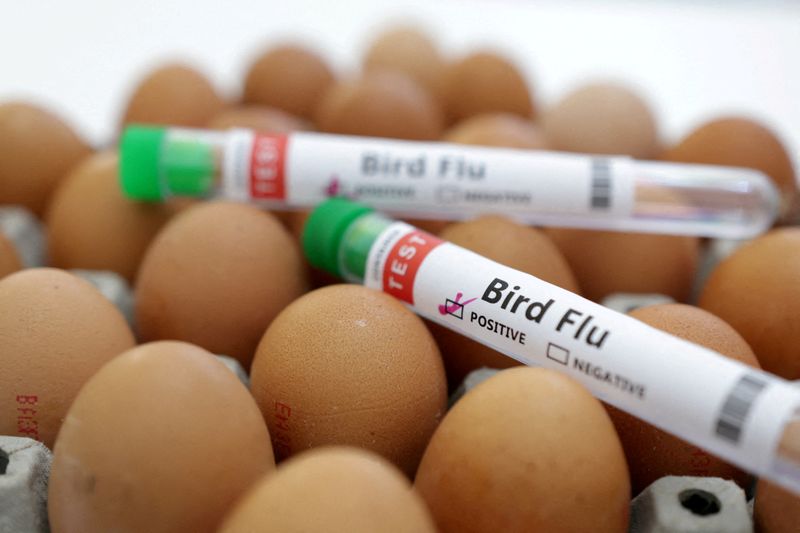Bird flu dairy cow outbreak widens in Ohio, Kansas, New Mexico

Bird flu has infected a dairy herd in Ohio for the first time and was detected in additional herds in Kansas and New Mexico, according to the U.S. government, expanding an outbreak in cows that has raised concerns about possible risks to humans.
The U.S. Department of Agriculture (USDA) has confirmed infections in herds across six states since it first reported cases in Texas and Kansas on March 25.
The infected dairy in Ohio received cows on March 8 from a Texas dairy, which later confirmed a detection of bird flu, the Ohio Department of Agriculture said.
The USDA has said transmission of the disease between cows cannot be ruled out.
The initial cases in Texas and Kansas appear to have been introduced by wild birds, and the strain of the virus in subsequent cases in New Mexico, Michigan and Idaho was very similar, according to USDA.

Migratory birds have spread avian flu around the globe since 2022, infecting poultry and other species.
“In the state of Kansas, all the genetic sequencing data that we can come up with is still indicating it is a spillover event from a wild bird exposure,” Kansas Animal Health Commissioner Justin Smith said in an interview on Thursday.
Bird flu has been found in three dairy herds in Kansas, two in New Mexico, seven in Texas and one each in Ohio, Idaho and Michigan, according to USDA.
The spread to an increasing number of species and its widening geographic reach have raised the risks of humans being infected, the head of the World Organization for Animal Health said on Thursday.
Texas officials reported on Monday that a farm worker tested positive, and the only symptom was eye inflammation. The U.S. Centers for Disease Control and Prevention considers the risk of bird flu for humans to be low.
Bird flu, also known as avian influenza, is a respiratory disease primarily affecting birds. It is caused by type A influenza viruses that naturally spread among wild aquatic birds worldwide. These viruses can infect domestic poultry and other bird and animal species. In rare cases, bird flu viruses can also infect humans.
Here are the main causes of bird flu:
-
Avian Influenza A Viruses: There are numerous strains of influenza A viruses, and some have the ability to infect birds. These particular viruses are categorized based on two proteins on their surface: hemagglutinin (H) and neuraminidase (N). There are 16 different hemagglutinin subtypes and 9 different neuraminidase subtypes.
-
Mutations: Bird flu viruses are constantly evolving, and mutations in the virus can allow it to infect new species, including humans. These mutations can happen when different influenza viruses co-infect an animal, allowing the viruses to swap genes and potentially create new strains.
-
Transmission: Bird flu viruses are spread through contact with infected birds or contaminated environments. Wild birds can carry the virus without showing symptoms and can introduce it into new areas through migration. Domestic poultry can become infected through contact with wild birds or contaminated water, feed, or equipment. Humans can become infected through close contact with infected birds or contaminated surfaces.
-
Bird flu itself isn’t a direct cause of illness in dairy cows, but there can be some indirect cause and effect:
Cause: Bird Flu in Wild Birds -> Potential Spread to Dairy Cows
- Wild birds can carry the virus without showing symptoms.
- Through migration or contact with contaminated areas, wild birds can introduce the virus to dairy farms.
Effect: Bird Flu Infection in Dairy Cows -> Impacts on Cows and Milk Production
-
If bird flu infects dairy cows, they can experience symptoms like decreased appetite, lower milk production, and respiratory issues.
-
However, it’s important to note that:
- This is a recent development, with the first cases detected in US dairy cows in March 2024.
- Scientists are still investigating how the virus is spreading among cows. There’s some evidence it might be due to milking equipment or worker clothing carrying the virus between animals, rather than direct airborne transmission (https://www.science.org/content/article/bird-flu-discovered-u-s-dairy-cows-disturbing).
Effects on Milk Safety and Consumption:
- Fortunately, there’s no cause for immediate concern about milk safety.
- Milk from infected herds is not allowed into the food supply.
- Pasteurization, a standard process for milk, effectively kills any viruses or bacteria that might be present.
Overall:
- Bird flu in wild birds can potentially spread to dairy farms.
- While infected cows can become sick and milk production might be affected, there’s no current risk to consumers due to safety measures.
- Scientists are actively researching how the virus is spreading among cows.
